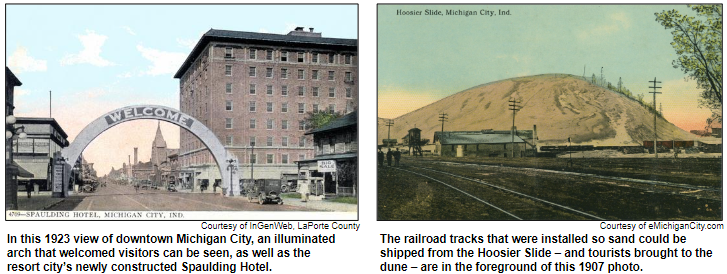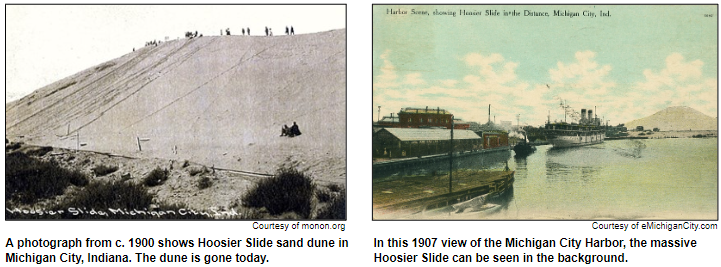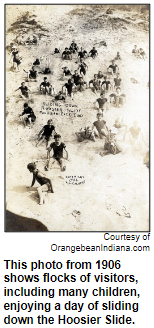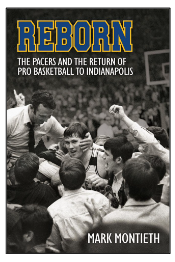A live weekly radio adventure through Indiana history with host Nelson Price. Airs live on Saturdays from noon to 1 pm ET at WICR 88.7 in Indianapolis.
You can also stream WICR live from anywhere. Go to www.wicronline.org or download the WICR HD1 app on your phone.
June 10, 2023
The largest Dune and why it’s gone

As by far the biggest of the Indiana Dunes on Lake Michigan, the legendary Hoosier Slide was a national tourist attraction. Sometimes likened to a sandy version of a Swiss Alp, the massive Hoosier Slide near Michigan City, Ind., stood 18.5 stories high and was the setting for wedding ceremonies, picnics and endless frolicking, with climbers and gawkers traveling by train or ferry to the towering dune during the late 1800s and early 1900s.
By 1920, though, the Hoosier Slide had disappeared.

Hoosier History Live will explore the heyday of the Hoosier Slide, the reasons it vanished from the landscape and the flourishing of Michigan City as a lakeside resort during the era that the huge dune captivated so many tourists. In particular, visitors from Chicago enjoyed spectacular views from atop the Hoosier Slide of Lake Michigan as well as Michigan City's vast lumberyards.
 Nelson's studio guest will be Christopher Taelman, who lives in Granger, which is a few miles north of the University of Notre Dame, near Indiana's state line with Michigan. Chris serves as chief development officer of the Hospice Foundation based in Mishawaka.
Nelson's studio guest will be Christopher Taelman, who lives in Granger, which is a few miles north of the University of Notre Dame, near Indiana's state line with Michigan. Chris serves as chief development officer of the Hospice Foundation based in Mishawaka.
For several years, Chris, a South Bend native and civic leader, was a manager with NIPSCO (Northern Indiana Public Service Co.). It's a utility with a generating station that now sits on the site of the Hoosier Slide, which Chris calls "a wonder of the Hoosier State and a lost landmark of Indiana's Lake Michigan shore."
According to Chris' research, excursion business to Michigan City to view the Hoosier Slide began to flourish as early as the 1880s. For comparison purposes with the Hoosier Slide's height of 18.5 stories, today's tallest Indiana Dune, Mount Baldy, is 11 stories high.
During a 30-year span from 1890 to 1920, though, the Hoosier Slide's sand was hauled away, mined for use by commercial endeavors in Indiana and Illinois. Initially hauled by wheelbarrows, massive amounts of sand eventually were transported from the dune by railroad cars. Among the businesses that used the sand was the glass-making industry, including the Ball Brothers in Muncie that became nationally famous for its canning jars. Glass-making businesses, which used sand in the production process, thrived in east central Indiana beginning in the late 1800s with the discovery of natural gas in the region. Hoosier History Live explored the Natural Gas Boom during a show in 2014.

 Michigan City also thrived during that era as a result of recreational and business ventures. "Michigan City offered some of the first large-scale recreational developments along the Indiana Dunes shoreline", Chris Taelman says. By 1910, steamer boats carried as many as 10,000 passengers a day to Michigan City's lakefront, he notes. Postcards featuring the Hoosier Slide were distributed across the country.
Michigan City also thrived during that era as a result of recreational and business ventures. "Michigan City offered some of the first large-scale recreational developments along the Indiana Dunes shoreline", Chris Taelman says. By 1910, steamer boats carried as many as 10,000 passengers a day to Michigan City's lakefront, he notes. Postcards featuring the Hoosier Slide were distributed across the country.
Meanwhile, trees on the Hoosier Slide were being cut down for use as lumber in the construction industry. "By removing plants and the root systems from the dune, sand began to blow and blanket Michigan City’s main business district", Chris says.
In addition to benefiting from the lumber and tourist industries during the late 19th century, Michigan City also flourished with commercial fishing and shipping industries. During this era, the Michigan City Salt Co. shipped 150,000 barrels of salt annually, according to Chris’ research.
The Hoosier Slide often was touted as "Indiana's most famous natural landmark". But just as the Natural Gas Boom ended when the gas was depleted, the sand that created the Hoosier Slide eventually was gone.

Your contributions help keep Hoosier History Live on the air, on the web and in your inbox!


 Guest Roadtripper
Guest Roadtripper 





